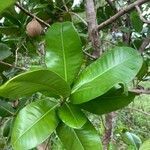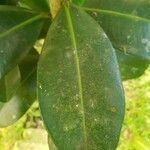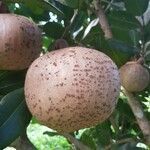Polygamous tree to 20 m tall, often narrow and densely leafy; sap yellow; twigs stout. Leaves broadly obovate or elliptical, apically rounded or slightly emarginate, basally rounded or obtuse, the margin minutely indurate, the costa subplane above, proximally canaliculate, conspicuously elevated and drying mi-nutely sulcate beneath; lateral nerves parallel, slightly ascending numerous in 2 similar series, 6-7 per cm (both series), anastomosing at the margin but not forming a submarginal vein, cross veins numerous, forming a rectangular retic-ulum, the areoles 1-2-punctate beneath, ca. 20 cm long, 10 cm wide; slightly discolorous, petiole stout, ca. 1 cm long, canaliculate above, the bases generally not connate or forming a petiolar ridge. Inflorescences 1-several flowers on twigs behind the leaves; pedicels stout, ca. 10 mm long. Flowers fragrant, the sepals 2, rotund, 10-15 mm long, cucullate, sometimes keeled coriaceous; petals ca. 6 white, spreading, rotund, shorter or longer than the sepals, stamens numerous, the filaments glabrous, slender, basally expanded and united into several whorls, the anthers of 2 longitudinal thecae separated by the undifferentiated connective; ovary pyriform, the style short, the stigma peltate, repand, centrally depressed. Fruit a large leathery globose berry to ca. 15 cm across, with thick brownish warty rind and thick fleshy orange or yellow pulp (mesocarp); locules 2-4, filled with the large, oblong slightly arcuate seeds 2.5-4 cm long which are covered with reddish brown fibrous material.
More
Trees often narrow and densely leafy, to 15(–20) m. Leaves: petiole stout, 10–15 mm; blade dark green, elliptic to obovate-elliptic, 9–25 × 5–11 cm, base cuneate to rounded, apex obtuse to rounded or retuse, tertiary reticulation dense. Inflorescences 3+-flowered (staminate) or 1-flowered (pistillate or bisexual). Pedicels 5–15 mm. Flowers: sepals orbiculate-concave, 1–1.5 × 1–1.5 cm; petals 4–6, imbricate, white, orbiculate, 1.5–2.5 cm; filaments basally expanded; ovary pyriform. Berries brown, globose or subglobose, 10–15 cm diam.; mesocarp fleshy, soft when ripe; endocarp reddish brown, fibrous. Seeds to 7 × 5.5 cm.
A medium sized evergreen tree. It grows 20-25 m tall. The leaves are glossy and oval. They are 10-20 cm long by 5-10 cm wide. The leaves are thick and have many parallel veins. Trees may have male and female flowers or they can be on separate trees. The flowers are showy and white. They are 5 cm across. The fruit is large, round, brown and sweet. They are 10-20 cm across. The skin is rough and leathery. It is about 3 mm thick. The flesh is deep orange. There are 4 seeds.
Has been cultivated for its fruit the “ Mamey apple ”, e.g.
It is a tropical plant. It can grow in the subtropics. It grows in areas with 1,500 mm of rain per year. It is damaged by frost. They will grow in a range of soils. It cannot tolerate poor drainage. It suits hardiness zones 10-12.
More
Within its natural range, mammee is most frequently found in semi-cultivation or in areas that have been disturbed.
The fruit is eaten fresh or cooked or used in jams. The fruit are best if sliced and left in water for a few hours. They are used to make ice-cream, drinks and preserves. The fruit can also be eaten with sugar and cream. The flowers are used to make an aromatic liqueur. The sap of the tree is used to make a fermented toddy.






